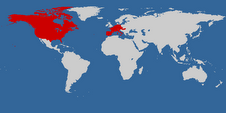
United Nations Environment Programme
Key Polar Centre
«Climate change is impacting biodiversity at a global and unprecedented scale.
The Arctic region is hit particularly hard. It is already warming 2 to 2.5 times faster than the global average, due to a thinner atmosphere and several positive feedback responses.
Changes in the Arctic will have major repercussions for all other global regions through changes in the hydrological cycle, the weather cycle, the carbon cycle or atmospheric changes, but also by impacting its unique biodiversity.
Many Arctic species are migratory, connecting the entire globe by their annual migration routes of billions of migratory birds, marine mammals and fish.
The changes in the Arctic region will determine the future of its major wealth in ecosystem goods and services, mostly its natural resources, marine and freshwater fish and terrestrial reindeer. They all provide vital income for the peoples of the North and to a large extent to the global community as a whole.
Its unique location in still largely pristine wilderness and little direct human impacts allow the Arctic region for monitoring the impact of climate change and industrial development on biodiversity in a less complex ecosystem, providing us with an early warning system of what is likely to happen to our near future.
Arctic biodiversity and ecosystems are an ideal test case for measuring progress towards the Convention on Biological Diversity's 2010 target to significantly reduce the rate of biodiversity loss by 2010, a barometer for the state of biodiversity.
The Circumpolar Biodiversity Monitoring Program is part of the International Polar Year initiative, which creates a huge scientific focus on the Polar regions, generating the attention to the vulnerable status of both poles. More than 100 projects focus on the Arctic region.
Arctic biodiversity is more than just the Polar Bear. This charismatic Arctic predator has been the focus of the media, rightly reporting on the sombre destiny of the largest predator on Earth. It will suffer severely if the sea ice continues to disappear in many areas of the Arctic. But little has been mentioned on the fate of other Arctic species, namely the following four.
● The charismatic, solely Arctic Ivory Gull pagophila eburnea is living entirely in High Arctic marine seas, closely associated with the Polar Bear, which it follows, scavenging on leftovers on the ice edge. Its entire life cycle is intimately linked with sea ice and the rare gull is potentially severely threatened by the disappearance of the sea ice.
● The Reindeer and Caribou rangifer tarandus are the most dominant large mammal species in the Arctic, living in every Arctic country, mostly in the tundra. They provide the major source of income for many local people in the Arctic, depending highly on the thriving of their huge populations. Climate change may have severe impacts on the future of this valuable element of Arctic ecosystems.
● Polar regions are home to 70% of all global freshwater, most of it stored in the ice sheets of Antarctica and Greenland, but the Arctic region contains the largest amount of freshwater available for biodiversity. Huge peatlands and tundra wetlands lie in the Arctic region, and Arctic rivers altogether discharge more than 4,600 km3 into the Arctic Ocean every year. Many of them belong to the largest ten rivers on Earth, hardly impacted by dams or any other human impacts, allowing a huge diversity of freshwater fish to thrive in their streams. The Arctic Char salvelinus alpinus is the most northerly distributed freshwater fish and a characteristic representative for this unique biome.
● The large majority of all Arctic vertebrates are migratory. Arctic breeding birds are connected with virtually every corner of the globe – apart from the Antarctic ice sheet – through the annual migration of birds, whales, fish and even reindeer and caribou. The Red Knot calidris canutus is one of the most fascinating globetrotters. In winter the High Arctic breeder can be found in South and West Africa, South America, India, Australia and New Zealand. However, four out of six populations are presently in decline, some sharply, and for two the trend is unknown.
These, like many other population trends from the Arctic regions, are alarming signals of changes in the Arctic ecosystems, which should alert us all. We still do not know the trend for many populations of Arctic biodiversity and we still know far too little as well to fully understand the root causes of these trends.»
Do you still believe never-ending economical growth rates are more important?
I don't! Not anymore!
RIC
segunda-feira, 15 de outubro de 2007
Climate change & biodiversity…
Subscrever:
Enviar feedback (Atom)




















13 comentários:
Ric, excelente e objectivo prisma este, da biodiversidade. Porque o mundo não é apenas a raça humana, porque o planeta se rege por rigorosos sistemas em frágil equilíbrio.
Urge lembrar, urge actuar. Valeu!
jocas repenicadas
Olá Graça!
Encontrar o assunto foi fácil. O mais complicado foi descobrir um texto minimamente «credível» no meio de muito palavreado (de que desconfio sempre muito...).
Creio que o grande problema é exactamente o fragilíssimo equilíbrio de todos os sistemas, quando nós humanos «achamos» que a Natureza é de ferro... As futuras gerações pagarão «as economias e as finanças e as bancas» e tudo o mais com juros a peso de ouro...
Beijinhos para ti também!
E muito obrigado pelo alerta! :-)
Se não acautelarmos o futuro no presente, teremos de pagar a cautela no futuro. Não gostaria de deixar uma factura que me envergonhasse perante as gerações vindouras. A destruição de alguns ecossistemas e o desiquilíbrio de outros faz parte da história da Terra, sem dúvida, mas não gosto de a ver associada à história do Homem. Infelizmente há muito quem conote a defesa ambiental com hippies fora de prazo ou com ecologistas histéricos. E isso é mau. Muito mau. E bem pouco humano.
Olá caro João!
Concordo integralmente com a tua linha de pensamento, meu caro!
É essa dependência directa da criação/evolução em relação à espécie humana que nunca se verificou outrora na História da Terra... E, à escala do relógio geológico, os desequilíbrios que temos introduzido no planeta nos últimos 200 a 300 anos são, no mínimo, assustadores... Mas parece que poucos responsáveis estão dispostos a reconhecê-lo, apesar do Nobel da Paz... Creio eu...
É muito mau, sim! E nada humano!
Um abraço para ti! :-)
Hoje era o blogue action day, e logo dedicado ao ambiente, tinha-me esquecido completamente.
Linda e doce a imagem das crias de urso polar.
Se os gelos do planeta continuarem a derreter muito em breve estes magníficos animais só se encontrarão nos jardins zoológicos.
Um abraço
Olá caro Paulo!
Qualquer dia pode ser um «Action Day», meu caro, se estivermos apostados em marcar a diferença. E o tema do ambiente foi escolhido para hoje, mas outros há que merecem destaque igual!
Também achei muito enternecedora a foto dos ursinhos na toca. Já a do urso adulto diz-nos que em breve esta poderá ser «imagem de arquivo»...
E, pelos vistos, muitas outras espécies árcticas estão ameaçadas... É realmente assustador!
Um abraço para ti também! :-)
O problema é que os efeitos do aquecimento global já tão sendo percebidos e, ao que parece, pouca gente tá se mobilizando pra resolver alguma coisa, né? Será que o ser humano é tão suicida assim?
O segredo está nas gerações futuras que intrinsecamente estarão como que programadas para não deixar que se chegue a consequências extremas. Um beijo em vós, ardente, como eu gosto, e vós, gostais?
Olá Leo!
Sinceramente, não sei... Sei é que, em momentos de maior crise, emergem das profundezas todos os misticismos, na esperança de que algum ente superior arranje o que o homem estragou... Já há quem fale em disputas sérias pelo controlo dos recursos naturais, portanto... O homem terá aquilo que quiser.
Abraço! :-)
Olá RIC.
Belo post, mas eu acho que é possível conciliar o desenvolvimento económico com a manutenção do equilibrio entre as várias espécies que habitam o planeta e evitar a diminuição da biodiversidade global.
É uma questão de bom senso e não só de quem governa,mas de todos nós.
É que não devemos esquecer que uma boa parte da população humana vive em condições miseráveis e os seus países necessitam de se desenvolver.
Abraços
Olá Condessa!
Como ainda estamos na «ressaca» de Fátima e das fantasias em torno dos seus segredos, a minha resposta só pode ser: «Fia-te na Virgem e não corras, e verás o grande trambolhão que dás...»
Já para não acentuar o facto de que «este» futuro começou... ontem.
Para vós, excelsa Condessa, os meus possíveis respeitos de voyeur não platónico, fogoso e ardente...
:-)
Olá caro Teddy Bear!
Concordo contigo, na generalidade, mas não sei exactamente o que significa, hoje em dia, «desenvolvimento económico». Aliás, o termo «desenvolvimento», em política e em economia, tem hoje o condão de me assustar...
Acresce o facto de que, se todos os dias se cria mais riqueza, mas há cada vez mais humanidade miserável, as possibilidades de mudar o curso dos acontecimentos estão em cada vez menos mãos que, obviamente, não querem que nada mude contra os seus interesses... Basta ver a questão dos combustíveis.
Sabemos que quem governa, hoje em dia, só nominalmente tem um mandato das populações...
Também é evidente que quem tem de lutar pela sua sobrevivência e dos seus, dia a dia, não pode estar preocupado com a extinção do urso polar...
Um abraço para ti também! :-)
and fat ass americansd still drive these massive house sized SUV vehicles that destroy the planet one mile at a time. I wish I could send all these drivers to Pluto in a ONE WAY TRIP.
Enviar um comentário